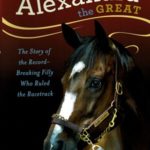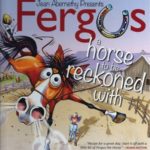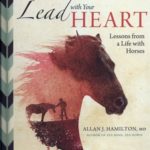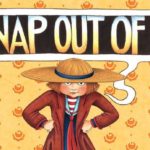
A gray sky marks the first blustery fall day in Upstate New York. Despite the brisk breeze and bone-chilling dampness, Kevin Cornwell and Gregory Tanczos refuse the offer of jackets and gloves, instead choosing to proudly show off their western shirts. The two friends, like the other 65 riders from across the state, are anxiously waiting to ride in the 2011 New York State Special Olympics Fall Games Equestrian Event.
Clutching the top rail of the holding arena, Greg watched rider after ridermount his favorite horse, EZ Tuffs Buster, known as “Buster.”
Because the Special Olympics Fall Games are taking place within driving distance of the stable Greg rides at every Friday night, his coach, Mary Murphy, trailered in several horses for riders to use during the day.
“I like to ride Buster because Buster’s my horse,” Greg says. For the past two years, Greg has taken riding lessons on Buster. Knowing that his class is almost the last class of the day makes it tough to watch all the other riders use Buster first.
“Greg gets anxious when he wants to ride,” his mother, Shelley Dante, explains. “It helps him learn to be patient and wait his turn.”
Buster, a 1994 American Quarter Horse gelding, has been a part of Mary’s program for riders with disabilities for six years.
“He can go from the roping pen to having these guys on his back without giving it a thought,” she says.
Kevin’s class, too, is not until late in the day.
“She’s trouble,” he says, pointing out one of the teenage girls who will be his side walkers and horse handler during his western equitationand western trail classes. The girls regularly volunteer at the stable where Kevin and Greg ride, and they grin at his light-hearted teasing.
Weaving his way through the crowd, Kevin points out Shade Of Hue, aka “Huey,” the 1992 Appendix gelding that he rides during his weekly lessons. Huey is the third Quarter Horse that Kevin has ridden during his 13 years of therapeutic riding lessons.
“It (riding) makes you feel relaxed,” Kevin says. “My favorite part is getting out of the house.”
Huey – who, like Buster, can easily transition down from a faster-paced sport – is Mary’s personal rodeo horse.
“I adopted Huey from a rescueeight years ago, and this is the first year I have used him in my therapeutic riding program,” she explains.
While Kevin watches an English equitationclass, his parents explain that a passion for horses runs in the family.
“Back in the 1930s, my grandfather was a starter for the horse races at the Altamont Fair,” says Doug Cornwell, Kevin’s father. “Then it skipped a generation. My father hated horses.”
Doug could not harness his interest and competed with Hackney and Welsh ponies but stopped showing when Kevin was born.
Twelve years ago, a day program that linked individuals with disabilities to various activities in the area suggested that Kevin participate in a therapeutic ridingprogram, and he has been hooked every since.
When Kevin first learned to ride, he struggled with his balance and required the help of side walkers who would have to give a push to get him back in the seat, his mother, Harriett, explains. Now he rides pretty much without their help.
The hours slowly creep by, and before long, Kevin and Greg both accept the offer of jackets and gloves to keep warm. When it is finally time to mount up, Kevin is misty-eyed from the nerves that have been building all day, while Greg grits his teeth and shivers.
When Kevin is called into the holding arena to mount, he tells his family, “I am going for the gold.” As soon as his foot is in the stirrup, a smile creeps in at the corners of his mouth. He and Greg both compete in western equitationand western trail, but in different classes. Each class has four or fewer riders, who are grouped based on riding ability. Some riders compete at the walk only, while others jog and walk. Depending on the riders’ abilities, they may be accompanied by a horse handler and two side walkers or may ride without assistance.
Kevin’s equitation class is first. As Huey is led into the arena, Kevin looks around for his family and coach, standing at the rail to cheer him on.
“Sit up straight,” he’s reminded. “Focus on what you are doing.”
With the help of a handler, who leads Huey, and two side walkers (volunteers who move around the ring with each horse and rider team), Kevin walks and jogs around the arena. The handler encourages Huey to jog when the judge calls for a change in speed. Side walkers stand on either side of Huey at Kevin’s legs to offer encouragement, and to help with balance if needed. When the judge asks riders to line up in the center of the ring for final scoring, Huey’s handler and the two side walkers join Kevin in the middle of the arena. The placing for the class will be announced during a podium ceremony after the division competes in trail.
Next, Kevin and Huey navigate the trail course. Listening to Kevin’s voice commands, Huey daintily steps over the ground polesand obediently waits for Kevin to tell him where to turn around each shrub and where to stop. The handler and side walkers stay with Kevin throughout the trail course to provide support and to help guide Huey through the pattern. Before dismounting, Kevin gives Huey a pat on the neck.
Greg’s class begins as soon as Kevin’s has finished. His concentration is focused on Buster rather than the crowd. A handler leads Buster, and two side walkers stay with Greg for the entire equitation class. When Greg asks Buster to jog, the handler also steps into a faster stride to encourage Buster to jog. Together, they walk and jog around the ring while the judge scores each rider. Once equitation is finished, Greg waits his turn for trail. He nudges Buster forward and over the ground poles.With the help of his horse handler and side walkers, Greg shows Buster what to do next. A look of relaxation crosses Greg’s face after he walks over the final log and gets ready to dismount.
At the end of their respective divisions, a podium celebration honors riders with a gold, silver or bronze medal. First is the equitation class. Kevin and Greg both receive silver.
Trail is announced next. Greg earns a second silver, and Kevin takes gold. After posing for a picture, Kevin leaps off the podium in triumph.
Eager to climb into a warm car, the crowd quickly shares congratulations and goodbyes. Kevin hugs his friends from the barn, and Greg gives a handshake.
Even through Kevin and Greg leave the horse show with their respective families, they will have a lot to talk about when they meet up at their apartment the following day. The two are roommates in a community residence operated by the Center for Disability Services near Albany. CFDS provides daily activities, community and support to help people with disabilities maintain their independence.
The Special Olympics Fall Games Equestrian Events included 20 classes that gave athletes the opportunity to compete against riders of similar ability levels in English equitation, English trail, western equitation and western trail. Divided into fall, winter, and summer Games, Special Olympics seasonal meets feature 22 different sports. The fall Games include bocce, cross country, cycling, golf and golf skills, equestrian, soccer team and softball team events. The Special Olympic World Games also includes dressage and western riding events, in addition to the equitation and trail classes most commonly held at local and state competitions.
Special Olympics is the largest amateur sports organization in the world. The New York state chapter is the largest in North American and the sixth largest worldwide. Based on a 2010 survey, Special Olympics New York has 51,809 athletes that train and compete year round at no cost to themselves, their families or caregivers.







